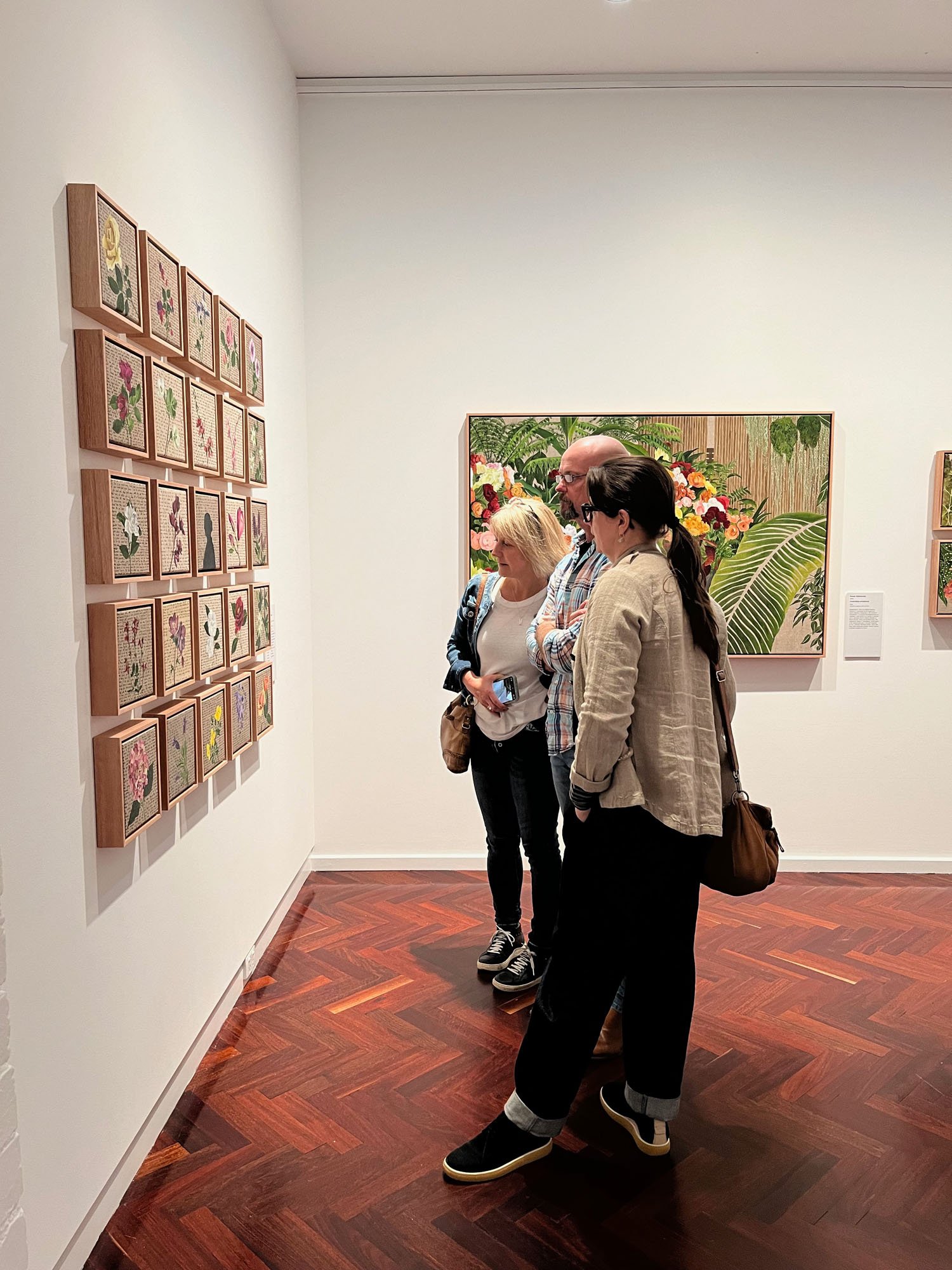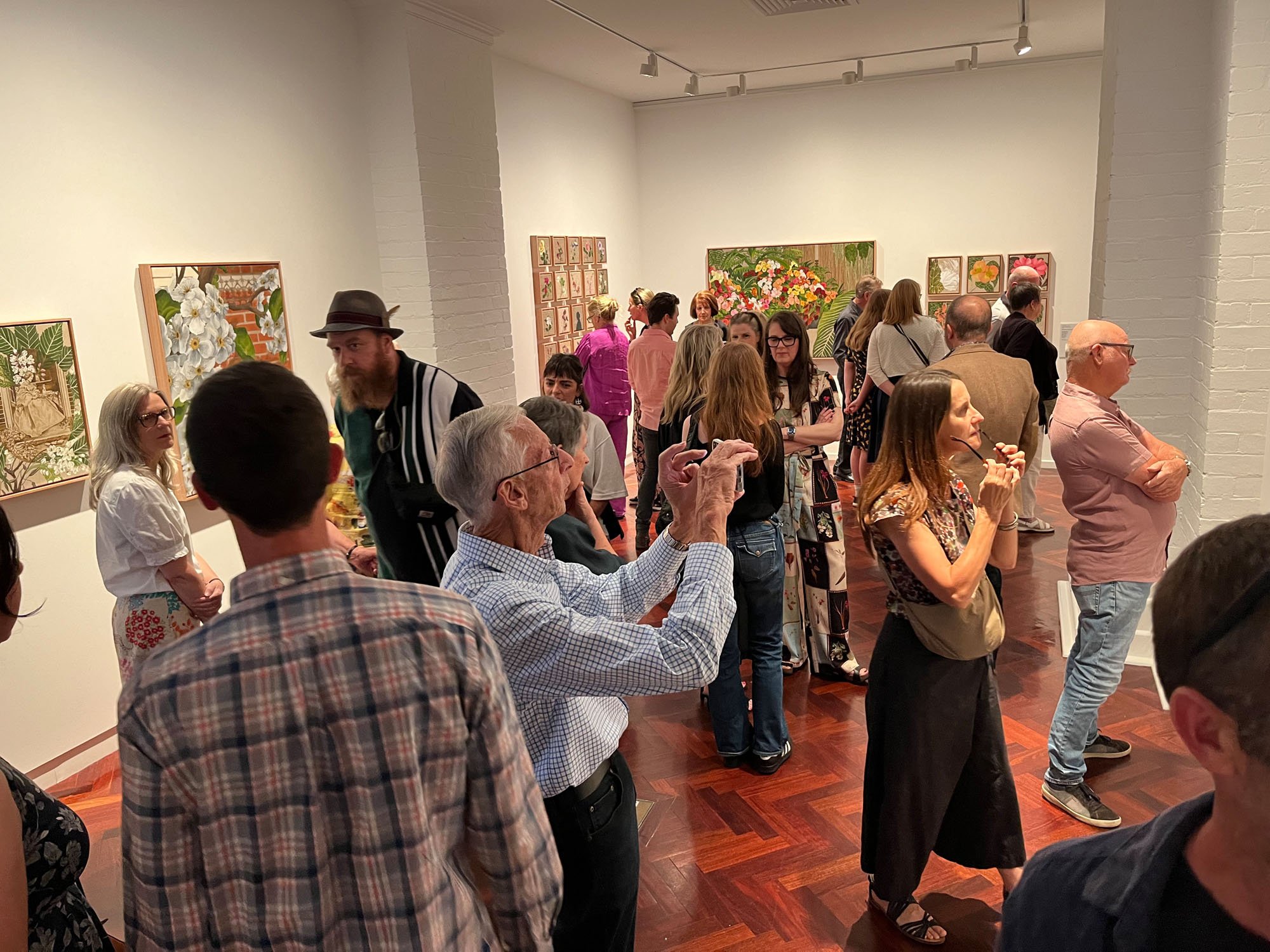Inisde my Solo Exhibition ‘An Ornamental Education’
In this video I give you a walk-through of my solo exhibition ‘An Ornamental Education’ at the Art Gallery of Ballarat 7th March -14th April 2024. This was my second solo show, my first in a public art gallery, which is an enormous honour. It took me on the most lovely and unexpected direction with my work which I’m excited to share with you.
I did a lot of historical research for this exhibition, both inside and outside the gallery archives, and wanted to share with you some of the fascinating history I discovered in the process about 19th century female botanical artists in Australia. This research connected deeply on many creative levels and the resulting work is a reflection of that process.
The first half of the video includes the tour and my commentary on the exhibition. The second half is the wonderful address that was given my dear friend and fellow artist Dr. Louisann King at the opening celebration held at the gallery on 8th March, which also happened to be International Women’s Day. It was so incredibly eloquent and brought so much depth in understanding about this body of work, that I really wanted to include it in full.
My thanks to the Art Gallery of Ballarat for allowing me to exhibit in their incredible space and for allowing me to share this exhibition with you here. Thanks also to curator Julie McLaren for her incredible work and support at each stage of this exhibition, it was hugely inspirational and really fun to dive into the collection with her. My thanks also to Ellen Becker and Paula Nicholson from the Ballarat Mechanics Institute for generously giving me a personal tour of the von Mueller Herbarium, and for allowing me to show some footage here.
I hope you enjoy the video! Suse xo
Video Transcript:
The Art gallery of Ballarat was founded in 1884 and is the oldest and largest regional art gallery in Australia. It’s housed in a beautiful heritage listed, purpose-built gallery building opened in 1890. From 1891-1907 if also operated its own school of art and the presence of university art schools in Ballarat has meant that art teachers and students continue to make use of the collection as I have done for this exhibition.
The Backspace Gallery celebrates the arts in the region through a vibrant and much-loved program. It provides early-career artists an opportunity to exhibit in a professionally supported gallery, it’s been an incredible honour to have the opportunity to mount a sole exhibition here.
The exhibition title ‘An Ornamental Education’ draws on the history of botanical art, particularly practiced by female artists of the 19th century. The artist I researched most extensively for this exhibition was Louisa Ann Meredith who you see depicted in this painting here. She was born in England in 1812 and emigrated to Australia and 1839, settling in Tasmania in 1840. She was a prolific writer, poet and painter and published many books in her lifetime.
I was lucky enough to be able to go into the archives at the art gallery with curator Julie McLaren and view first-hand some of the beautiful works on paper held there.
This triggered an intense research phase and immense inspiration for exploring the history of botanical painting through my own art. You see here how I have used the imagery Louisa Anne painted of Tasmanian laurel for her book “Bush Friends in Tasmania’ in the portrait that I painted of her seated outside her home in Tasmania. Her books and the art she created for them became the anchor point of this exhibition.
This research also led me to reflect more deeply on the impact of European colonisation on the gardens and landscape we live in today.
This painting of blossoms in front of a brick Victorian house in my local neighbourhood, titled ‘The Past is Present’ reflects on the enduring consequences of colonialism that enabled the establishment of towns such as Ballarat that look like they were lifted out of England.
I love the beauty of my town, its Victorian ambiance, and the English style gardens that are in abundance here. I even live in a house built in the 1860's. But there is a shadow that will always remain- one that reminds us of what was here before the impact colonialisation on this land of the Wadawurrung people. A land of very different flora, cared for by First Nations people. It is in that uncomfortable awareness that I bring forward this story of early female colonial artists and the art that they made. In recognition of the layering of Indigenous and European cultures that create the landscape that I live in today
This grouping of 25 flower portraits is titled ‘An Ornamental Education’. During the 18th and 19th century, girls of the middle and upper classes in England were given was commonly referred as an ‘ornamental education’. This typically included ‘ladylike accomplishments’ of drawing, dancing, fancy work, recitation, Romance languages and taste in dress. Female artists of this time were further limited to three ‘gendered genres’ deemed appropriate for women to practice: miniature portrait painting, flower painting and picturesque landscape painting. Louisa Anne Meredith practiced all three. You can see a silhouette of her in the centre of the arrangement. Before the invention of photography, creating cut silhouettes of the profile were a common way to capture a portrait.
Each flower in this series was collected from my own garden, those of friends and family, or in my local neighbourhood. I wrote poetry and prose by Louisa Anne Meredith with a dip pen on the linen supports for these paintings before painting the flower. This deep immersion in Louisa’s words, many of which captured her deep love of nature, was the perfect backdrop to give myself the experience of an ‘ornamental education’ in the painting of botanicals.
Throughout the process of creating work for this exhibition I have reflected on the great love of gardening in my hometown of Ballarat, through a deep dive into our internationally famous Begonia festival. Founded in 1953, the Ballarat Begonia festival is a showcase for the largest and rarest collection of Begonia’s in the Southern Hemisphere. It is unusual that Ballarat chose to celebrate a plant which is not native to Australia and is generally found in tropical climates of South America, Africa, and Southern Asia. The magnificent display in the Conservatory is as much impactful as it is a reminder that these plants, along with many other introduced species, require carefully controlled conditions to thrive.
In many of these works I have combined the use of collage and painting to explore the gorgeous pattern, texture, and variety to be found in these plants. The colour and abstracted style of these works also evoke the mid-century modern roots of the festival.
Botany was at the height of popularity in Australia in decades that followed European colonisation. Herbariums, books which contained pressed botanicals attached to sheets of paper, were assembled to record, and categorise new discoveries of plants. Many early colonial female artists made significant contributions to the field through their collecting, including Louisa Anne Meredith. Over 200 women regularly sent their samples to Baron Ferdinand von Mueller, government appointed botanist for the then colony of Victoria, in 1852 , and later director of the Royal Botanic Gardens in Melbourne. He also founded the National Herbarium of Victoria. He named many Australian plants, including several that he dedicated to the women. These circular paintings contain collaged silhouettes of plants cut from mono-prints that reflect the flattening process that happened in the Herbarium construction. These circles also evoke the form of embroidery hoops, and the linen cloth that was used in the substrates for this entire exhibition, that nods to coarsely woven cloth of these colonial times.
In both 19th Century England and Australia, women were limited in the ways they could participate in the science of botany. They were presented with an edited version of the science that excluded the sexual classification of plants deemed unseemly for women. This spawned the writing and publication of gardening and botany books, often written by women for women. It also led to new ways of depicting bouquets of botanicals that represented a new genre in botanical illustration quite different to those that appeared in the scientific botanical publications. These four paintings of bouquets of flowers from my own environment are a nod to that much overlooked contribution to the genre of botanical painting. Illustrating bouquets of flowers was also one of the important ways colonial women forged a connection with their new and unfamiliar home and found their place within it.
All remaining works and the limited edition jigsaw puzzle are available for sale on my website susannethercote.com
Donate the price of a coffee to support this channel on my KOFI page (thank you!) https://ko-fi.com/Y8Y0PTP3J
SUPPORT THE PODCAST & YOUTUBE CHANNEL
subscribe | Click the subscribe button in your favourite podcast player to never miss an episode. Subscribe to my YouTube channel to get a richer, more visual experience of what I talk about on the podcast.
review | If you love the podcast leave a review! This assists other people to find the podcast so I can help them too
share | Tell more people about the podcast by sharing a screenshot in your Instagram stories, Facebook or tell a friend in real life!
support | If you would like to financially support my podcast and You Tube videos, consider purchasing some art, a print or an e-course at one of the links above. Or you could leave a tip the price of a coffee on my Kofi page
Thanks so much for being here!
Suse xo






